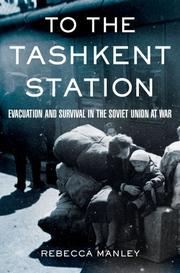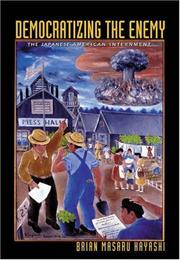| Listing 1 - 10 of 32 | << page >> |
Sort by
|
Book
Year: 1956 Publisher: Washington : National Academy of Sciences, National Research Council,
Abstract | Keywords | Export | Availability | Bookmark
 Loading...
Loading...Choose an application
- Reference Manager
- EndNote
- RefWorks (Direct export to RefWorks)
Evacuation of civilians. --- United States --- Military policy.
Book
Year: 1950 Publisher: London : H. M. Stationery Off.,
Abstract | Keywords | Export | Availability | Bookmark
 Loading...
Loading...Choose an application
- Reference Manager
- EndNote
- RefWorks (Direct export to RefWorks)
World War, 1939-1945 --- Civilian relief. --- Evacuation of civilians.
Book
Year: 1940 Publisher: Paris : Tallandier,
Abstract | Keywords | Export | Availability | Bookmark
 Loading...
Loading...Choose an application
- Reference Manager
- EndNote
- RefWorks (Direct export to RefWorks)
World War, 1939-1945 --- Evacuation of civilians. --- Personal narratives, French.
Book
Year: 1950 Publisher: London : Stationery Off.,
Abstract | Keywords | Export | Availability | Bookmark
 Loading...
Loading...Choose an application
- Reference Manager
- EndNote
- RefWorks (Direct export to RefWorks)
World War, 1939-1945 --- Civilian relief. --- Evacuation of civilians.
Book
ISBN: 9780226135984 0226135985 9780226135991 0226135993 Year: 2012 Publisher: Chicago ; London : University of Chicago Press,
Abstract | Keywords | Export | Availability | Bookmark
 Loading...
Loading...Choose an application
- Reference Manager
- EndNote
- RefWorks (Direct export to RefWorks)
Refugee children --- Kommounistikon Komma tēs Hellados. --- Greece --- History --- Refugees --- Children. --- Evacuation of civilians.
Book
ISBN: 1282627201 9786612627200 1845458168 1845457250 9781282627208 9781845458164 Year: 2013 Publisher: New York : Berghahn Books,
Abstract | Keywords | Export | Availability | Bookmark
 Loading...
Loading...Choose an application
- Reference Manager
- EndNote
- RefWorks (Direct export to RefWorks)
The early twentieth-century advent of aerial bombing made successful evacuations essential to any war effort, but ordinary people resented them deeply. Based on extensive archival research in Germany and France, this is the first broad, comparative study of civilian evacuations in Germany and France during World War II. The evidence uncovered exposes the complexities of an assumed monolithic and all-powerful Nazi state by showing that citizens' objections to evacuations, which were rooted in family concerns, forced changes in policy. Drawing attention to the interaction between the Germans
Bombing, Aerial -- Social aspects -- Germany -- History -- 20th century. --- World War, 1939-1945 -- Aerial operations. --- World War, 1939-1945 -- Evacuation of civilians -- France. --- World War, 1939-1945 -- Evacuation of civilians -- Germany. --- World War, 1939-1945 --- Bombing, Aerial --- Evacuation of civilians --- Aerial operations --- History --- Social aspects --- Social aspects.

ISBN: 3486645781 348670298X 9783486702989 Year: 1999 Publisher: De Gruyter
Abstract | Keywords | Export | Availability | Bookmark
 Loading...
Loading...Choose an application
- Reference Manager
- EndNote
- RefWorks (Direct export to RefWorks)
Millionen Deutsche waren im Zweiten Weltkrieg vor den alliierten Bombern auf der Flucht aus den Städten. Pläne für die Evakuierung gab es nicht, das NS-Regime nahm die Gefährdung der Zivilbevölkerung billigend in Kauf. Als die Reichsführung im Frühjahr 1943 endlich aktiv wurde, war es zu spät: Das ganze Reichsgebiet war inzwischen Luftkriegsgebiet. Was nur als vorübergehende Notlösung geplant war, wurde für viele Evakuierte zum jahrelangen Dauerzustand: Leben in einem fremden Umfeld, in primitiven Verhältnissen, getrennt von der Familie. Eine Lösung bahnte sich erst im Jahre 1953 mit dem Erlass des Bundesevakuiertengesetzes an. In der Studie werden politische Entscheidungsprozesse und Wirkungen der Evakuierungen auf zentraler Ebene und vor Ort untersucht sowie die Erfahrungen der Betroffenen, Einheimischer wie Evakuierter, am Beispiel Bayerns aufgezeigt.
World War, 1939-1945 --- -World War, 1939-1945 --- -European War, 1939-1945 --- Second World War, 1939-1945 --- World War 2, 1939-1945 --- World War II, 1939-1945 --- World War Two, 1939-1945 --- WW II (World War, 1939-1945) --- WWII (World War, 1939-1945) --- History, Modern --- Evacuation of civilians --- -Refugees --- -Bavaria (Germany) --- -History --- -Evacuation of civilians --- Refugees --- Bavaria (Germany) --- History. --- European War, 1939-1945
Book
ISBN: 1469630931 1469630923 9781469630922 9781469630939 9781469630908 1469630907 9781469630915 1469630915 9798890850324 Year: 2017 Publisher: Chapel Hill : Baltimore, Md. : University of North Carolina Press, Project MUSE,
Abstract | Keywords | Export | Availability | Bookmark
 Loading...
Loading...Choose an application
- Reference Manager
- EndNote
- RefWorks (Direct export to RefWorks)
In 1961, the U.S. government established the first formalised provisions for intercountry adoption just as it was expanding America's involvement with Vietnam. Adoption became an increasingly important portal of entry into American society for Vietnamese and Amerasian children, raising questions about the United States' obligations to refugees and the nature of the family during an era of heightened anxiety about U.S. global interventions. Whether adopting or favouring the migration of multiracial individuals, Americans believed their norms and material comforts would salve the wounds of a divisive war.
Vietnamese --- Amerasians. --- Adopted children --- Vietnam War, 1961-1975 --- Intercountry adoption --- International adoption --- Transnational adoption --- Adoption --- Interracial adoption --- Adopted infants --- Children, Adopted --- Children --- Amer-Asians --- Americans --- Asians --- Evacuation of civilians. --- Children.

ISBN: 9780801447396 0801447399 1322505322 0801457769 0801459001 9780801459009 9780801457760 Year: 2009 Publisher: Ithaca : Cornell University Press,
Abstract | Keywords | Export | Availability | Bookmark
 Loading...
Loading...Choose an application
- Reference Manager
- EndNote
- RefWorks (Direct export to RefWorks)
In summer and fall 1941, as German armies advanced with shocking speed across the Soviet Union, the Soviet leadership embarked on a desperate attempt to safeguard the country's industrial and human resources. Their success helped determine the outcome of the war in Europe. To the Tashkent Station brilliantly reconstructs the evacuation of over sixteen million Soviet civilians in one of the most dramatic episodes of World War II. Rebecca Manley paints a vivid picture of this epic wartime saga: the chaos that erupted in towns large and small as German troops approached, the overcrowded trains that trundled eastward, and the desperate search for sustenance and shelter in Tashkent, one of the most sought-after sites of refuge in the rear. Her story ends in the shadow of victory, as evacuees journeyed back to their ruined cities and broken homes. Based on previously unexploited archival collections in Russia, Ukraine, and Uzbekistan, To the Tashkent Station offers a novel look at a war that transformed the lives of several generations of Soviet citizens. The evacuation touched men, women, and children from all walks of life: writers as well as workers, scientists along with government officials, party bosses, and peasants. Manley weaves their harrowing stories into a probing analysis of how the Soviet Union responded to and was transformed by World War II. Over the course of the war, the Soviet state was challenged as never before. Popular loyalties were tested, social hierarchies were recast, and the multiethnic fabric of the country was subjected to new strains. Even as the evacuation saved countless Soviet Jews from almost certain death, it spawned a new and virulent wave of anti-Semitism. This magisterial work is the first in-depth study of this crucial but neglected episode in the history of twentieth-century population displacement, World War II, and the Soviet Union.
Refugees --- World War, 1939-1945 --- History. --- Evacuation of civilians --- Soviet Union --- Tashkent (Uzbekistan) --- History --- Displaced persons --- European War, 1939-1945 --- Second World War, 1939-1945 --- World War 2, 1939-1945 --- World War II, 1939-1945 --- World War Two, 1939-1945 --- WW II (World War, 1939-1945) --- WWII (World War, 1939-1945) --- Persons --- Aliens --- Deportees --- Exiles --- History, Modern

ISBN: 0691009457 0691138230 9786612964862 140083774X 1282964860 9781400837748 9780691138237 9781282964860 Year: 2004 Publisher: Princeton, N.J. : Princeton University Press,
Abstract | Keywords | Export | Availability | Bookmark
 Loading...
Loading...Choose an application
- Reference Manager
- EndNote
- RefWorks (Direct export to RefWorks)
During World War II some 120,000 Japanese Americans were forcibly removed from their homes and detained in concentration camps in several states. These Japanese Americans lost millions of dollars in property and were forced to live in so-called "assembly centers" surrounded by barbed wire fences and armed sentries. In this insightful and groundbreaking work, Brian Hayashi reevaluates the three-year ordeal of interred Japanese Americans. Using previously undiscovered documents, he examines the forces behind the U.S. government's decision to establish internment camps. His conclusion: the motives of government officials and top military brass likely transcended the standard explanations of racism, wartime hysteria, and leadership failure. Among the other surprising factors that played into the decision, Hayashi writes, were land development in the American West and plans for the American occupation of Japan. What was the long-term impact of America's actions? While many historians have explored that question, Hayashi takes a fresh look at how U.S. concentration camps affected not only their victims and American civil liberties, but also people living in locations as diverse as American Indian reservations and northeast Thailand.
Japanese Americans --- Evacuation and relocation, 1942-1945. --- Evacuation and relocation of Japanese Americans, 1942-1945 --- Internment of Japanese Americans, 1942-1945 --- Relocation of Japanese Americans, 1942-1945 --- World War, 1939-1945 --- Evacuation of civilians --- Evacuation and relocation, 1942-1945 --- Forced removal of Japanese Americans, 1942-1945 --- Forced removal of civilians --- Forced removal and internment, 1942-1945.
| Listing 1 - 10 of 32 | << page >> |
Sort by
|

 Search
Search Feedback
Feedback About UniCat
About UniCat  Help
Help News
News